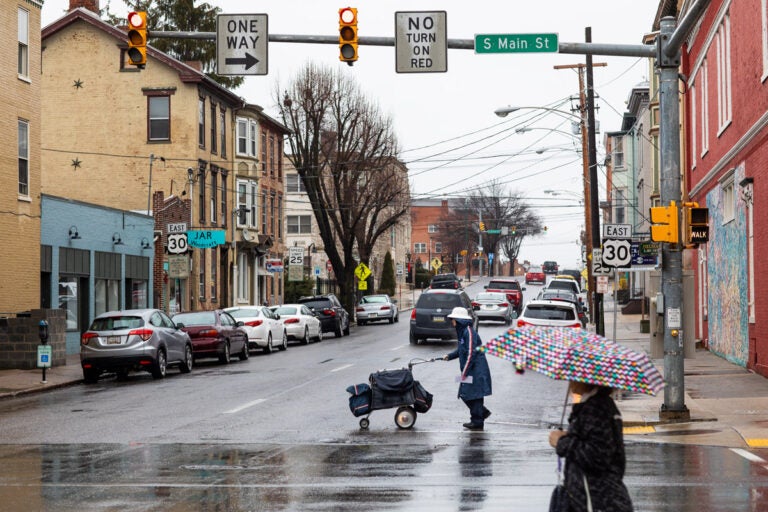Clash over reopening economy simmers below the surface in rural Pa. COVID hotspot
In parts of rural Pa. there has been growing angst about Gov. Tom Wolf’s coronavirus shutdown plan.
Listen 5:24
Chambersburg, Pa. which has seen a spike in COVID-19 cases in recent weeks, is in a county where state lawmakers are pushing for a faster reopening of the economy. (Jeffrey Stockbridge for Keystone Crossroads)
Are you on the front lines of the coronavirus? Help us report on the pandemic.
Rodrigo Ortiz has been trying to sound the alarm about COVID-19. At the end of April, he stood outside of a coronavirus testing site in downtown Chambersburg wearing a white face mask and turned on Facebook Live.
“There’s a lot of people who think nothing will happen to them, and keep getting together, keep having parties,” he said in Spanish into the camera, before imploring residents of the borough to stay home to avoid spreading the coronavirus.
“Sixty percent of people here are testing positive, and the majority are Hispanics,” he continued, with emotion.
Ortiz posted the video to the page for MILPA, a statewide grassroots advocacy group run by and for Latinx immigrants, where it now has more than 6,100 views.
In parts of rural Pennsylvania, there has been growing angst about Gov. Tom Wolf’s coronavirus shutdown plan. In places where case counts have remained low, some say the state isn’t acting fast enough to reopen the economy. But in pockets where COVID-19 cases have had dramatic spikes, the feeling is more cautious.
In Franklin County, both scenarios exist simultaneously.
The county leans Republican politically, and is home to dairy farms, food production and warehouses that keep the local economy chugging.
Chambersburg, the county seat, is more densely settled and much more politically and racially diverse — around 12% of its 21,000 residents are African American, and 17% are Latinx, according to the U.S. Census Bureau.
In parts of the county, the coronavirus feels like a far-away problem. In the borough, it’s hitting close to home.
Chambersburg accounts for about half of the more than 560 COVID-19 cases in Franklin County. Fifteen county residents have died of the virus as of May 14, according to the Pennsylvania Department of Health. WellSpan Chambersburg Hospital reports 21 deaths, but some of them may not have been Franklin County residents.
In early May, the borough briefly landed in a list of the top 15 places where COVID-19 cases had the highest average daily growth rate, according to a national New York Times analysis.

Ortiz and the other members of MILPA have been working around the clock to spread the word and convince people to stay home. He hands out masks on the street, and the group tapped a local network of churches to raise money for a kind of mobile food bank, aimed at slowing the spread of the virus.
“If you have coronavirus, you shouldn’t be showing up at a food pantry,” said Ben Raber, executive director of NETwork Ministries, who is helping with the effort, along with attempts to alleviate COVID-related hunger in the region. “We’re really trying to see to it so that nobody is going hungry,” he said.
‘Surrender our rights’
Efforts to keep people home are undercut by messaging that the economy needs to reopen immediately.
Some local officials are agitating against the shutdown order, pointing out that case numbers in Franklin County are not on the scale of harder hit places, such as the Philadelphia area and New York City. Around 1% of Philadelphia County residents have tested positive, compared to around .36% in Franklin County.
On May 9, six local state lawmakers and one county commissioner signed a letter to Gov. Tom Wolf, stating their intention to move out of the state’s most restrictive “red” lockdown phase.
“Franklin County has met the requirement of your original stay-at-home order, which was to flatten the curve of the COVID-19 outbreak and allow hospitals time to gear up,” they wrote, announcing businesses could begin opening May 15.
In response to the letter and others from around the state, Wolf said he could withhold funding from counties that don’t cooperate and pull the licenses of scofflaw businesses.
“I am just really troubled at how quickly we’re willing to surrender our rights,” said State Senator Doug Mastriano, a Republican who serves four counties who penned and signed the letter. He said the uncertainty around how long the shutdown order will last troubles some of his constituents.
While the authority of officials who want to flout the state order is limited, he said, “basically what we’re saying is, ‘Businesses, we’ll let you decide what to do.’”
Mastriano, who has been a leading voice at shutdown protest rallies in Harrisburg, has called for the resignation of Pennsylvania Health Secretary Rachel Levine.
I formally requested the resignation of PA Department of Health Secretary Rachel Levine during a Monday morning press conference, citing ongoing flaws with the COVID-19 emergency declaration and mitigation efforts. @PASenateGOP https://t.co/ObSN7VCJaA pic.twitter.com/QZSoBcVOUL
— Senator Doug Mastriano (@SenMastriano) May 11, 2020
Several key figures in Chambersburg’s local government have not signed Mastriano’s letter, and are giving the opposite advice.
Mayor Walt Bietsch issued his own responses, saying, “While the appropriateness of the ‘red’ phase designation is subject to debate, local elected officials do not have the authority to independently permit non-waivered businesses to open.”
The two county commissioners who did not support bucking the shutdown order also weighed in. “We, too, are frustrated with the restrictions surrounding this crisis,” wrote commissioners Dave Keller and Robert Ziobrowski. “But, we do not believe it is in the best interest of our residents or our businesses to act against the Governor’s Office protocol.”
‘Extra important’
Borough Council President Alice Elia said the mixed messages have led to some confusion and questions from residents and business owners, asking can we reopen or not?
“I felt that it was really important to clear that up,” she said. Because the borough is harder hit than much of the surrounding area, “it’s extra important that our residents maintain social distancing, wear their masks and stay home,” said Elia.
There are several factors that could contribute to why the borough has more cases than surrounding areas, according to Elia. It’s denser, contains some nursing homes, and is home to more people of color who, nationally, are coming down with the coronavirus at disproportionate rates.
“I do worry that not only in Chambersburg but around the country … we’re going to have pockets of people who are stigmatized,” she said.
Keystone Health, the federally qualified health center that runs the testing site in downtown Chambersburg, declined to verify the demographics of who is testing positive.
Ortiz said there are other factors as well. In the Latinx community, he said many people are still going to work in essential industries, and families live in close proximity. There was also a lack of clear guidance and an abundance of misinformation on social media, and as a result, a slow adoption of social distancing processes.
There are many people who are afraid, or who don’t want to pay so they don’t go to the doctor, according to Ortiz. That’s why MILPA has tried to get the word out that testing at Keystone Health is free.
A group including nurses, business owners, church leaders and MILPA members put out a public service announcement called “Stay at Home,” asking people to take warning about the coronavirus seriously.
Since the recent spike in cases, the numbers have plateaued in Franklin County, according to the two local health care providers, Wellspan and Keystone Health.
The hope is that clear communication efforts will help keep driving the trend downward.
Laura Benshoff produced this story as part of the America Amplified initiative using community engagement to inform and strengthen local, regional and national journalism. America Amplified is a public media initiative funded by the Corporation for Public Broadcasting. WHYY is part of the America Amplified network. Reporter Laura Benshoff is following stories that community members identify as deserving of more coverage in Chambersburg, Pennsylvania.
Q: What did the people you talked to say about the experience of being interviewed for public media?
Most did not address what it felt like specifically to be interviewed, but people did reflect on the state of local media. Many people complained of shallow local coverage — of TV stations based in other cities and newspapers filling pages with content from elsewhere, meaning less for locals to read about their borough. Some people were therefore grateful to be asked about hyperlocal issues. In other cases, people were suspicious and critical of media in general.
Q: What surprised you about this type of community engagement?
I’ve been reporting in Chambersburg since last fall as part of Keystone Crossroads’ Embedded2020 project, so I’ve been able to build relationships over time. I’ve also benefited from some surveys carried out by two academics, one of whom grew up in Chambersburg, identifying news needs. I’ve never had the experience of getting such a thorough look at dominant issues before I even start reporting, and I find it makes for a really solid foundation. Once you know a bit about what issues people care about, it’s easier to find stories that cut across silos and traditional affiliations.
Q: What lessons do you have for others who want to do the same?
Only promise what you can deliver. A grant-funded reporting project is not a replacement for a hyperlocal news source, but it can complement existing news sources and add value. I think being honest about what my capacity as a reporter is, what works as a story and what doesn’t, and what I don’t know helps create reasonable expectations and therefore better relationships.
WHYY is your source for fact-based, in-depth journalism and information. As a nonprofit organization, we rely on financial support from readers like you. Please give today.





![CoronavirusPandemic_1024x512[1]](https://whyy.org/wp-content/uploads/2020/03/CoronavirusPandemic_1024x5121-300x150.jpg)


